Software Project Management Rational Unified Framework Bojana Milainovi

Software Project Management Rational Unified Framework Bojana Milašinović bojana@rti 7020. etf. bg. ac. yu Ivanka Milenković vanjaaaa@hotmail. com Veljko Milutinović vm@etf. bg. ac. yu "Software Project Management" Walker Royce 1

Part 1 Software Management Renaissance Introduction o o In the past ten years, typical goals in the software process improvement of several companies are to achieve a 2 x, 3 x, or 10 x increase in productivity, quality, time to market, or some combination of all three, where x corresponds to how well the company does now. The funny thing is that many of these organizations have no idea what x is, in objective terms. "Software Project Management" Walker Royce 2

Part 1 Software Management Renaissance "Software Project Management" Walker Royce 3

Part 1 Software Management Renaissance Table of Contents (1) o The Old Way (Conventional SPM) Ø The Waterfall Model Conventional Software Management Performance o Evolution of Software Economics Ø Ø Ø Software Economics Pragmatic Software Cost Estimation "Software Project Management" Walker Royce 4

Part 1 Software Management Renaissance Table of Contents (2) o Improving Software Economics Ø Reducing Software Product Size Improving Software Processes Improving Team Effectiveness Improving Automation through Software Environments Achieving Required Quality Peer Inspections: A Pragmatic View o The Old Way and the New Ø Ø Ø Ø The Principles of Conventional Software Engineering The Principles of Modern Software Management Transitioning to an Iterative Process "Software Project Management" Walker Royce 5

The Old Way "Software Project Management" Walker Royce 6

Part 1 The Old Way o Software crisis Ø “The best thing about software is its flexibility” Ø Ø It can be programmed to do almost anything. “The worst thing about software is also its flexibility” Ø The “almost anything ” characteristic has made it difficult to plan, monitor, and control software development. "Software Project Management" Walker Royce 7

Part 1 The Old Way The Waterfall Model System requirements Software requirements Analysis o Ø Ø Ø Program design Drawbacks Protracted integration and late design breakage Late risk resolution Requirements - driven functional decomposition Adversarial stakeholder relationships Focus on document and review meetings Coding "Software Project Management" Walker Royce Testing Maintenance and reliance 8

Part 1 The Old Way Conventional Software Management Performance 1. 2. 3. 4. 5. 6. 7. 8. 9. Finding and fixing a software problem after delivery costs 100 times more than finding and fixing the problem in early design phases. You can compress software development schedules 25% of nominal, but no more. For every $1 you spend on development, you will spend $2 on maintenance. Software development and maintenance costs are primarily a function of the number of source lines of code. Variations among people account for the biggest differences in software productivity. The overall ratio of software to hardware costs is still growing. In 1955 it was 15: 85; in 1985, 85: 15. Only about 15% of software development effort is devoted to programming. Walkthroughs catch 60% of the errors. 80% of the contribution comes from 20% of contributors. "Software Project Management" Walker Royce 9

Part 1 Evolution of Software Economics "Software Project Management" Walker Royce 10

Part 1 Evolution of Software Economics q Most software cost models can be abstracted into a function of five basic parameters: Ø Ø Ø Size (typically, number of source instructions) Process (the ability of the process to avoid non-valueadding activities) Personnel (their experience with the computer science issues and the applications domain issues of the project) Environment (tools and techniques available to support efficient software development and to automate process) Quality (performance, reliability, adaptability…) "Software Project Management" Walker Royce 11

Part 1 Evolution of Software Economics Three generations of software economics Cost Software size 1960 s-1970 s Waterfall model Functional design Diseconomy of scale 1980 s-1990 s Process improvement Encapsulation-based Diseconomy of scale 2000 and on Iterative development Component- based Return to investment Environments/tools: Custom Size: 100% custom Process: Ad hoc Environments/tools: Off-the-shelf, separate Size: 30%component-based, 70% custom Process: Repeatable Environments/tools: Off-the-shelf, integrated Size: 70%component-based, 30% custom Process: Managed/measured Typical project performance Predictably bad Always: -Over budget -Over schedule Unpredictable Infrequently: -On budget -On schedule "Software Project Management" Walker Royce Predictable Usually: -On budget -On schedule 12

Part 1 Evolution of Software Economics The predominant cost estimation process Software manager, software architecture manager, software development manager, software assessment manager Cost modelers Risks, options, trade-offs, alternatives Cost estimate "Software Project Management" Walker Royce 13

Part 1 Evolution of Software Economics Pragmatic software cost estimation o A good estimate has the following attributes: Ø It is conceived and supported by the project manager, architecture team, development team, and test team accountable for performing the work. Ø It is accepted by all stakeholders as ambitious but realizable. Ø It is based on a well defined software cost model with a credible basis. Ø It is based on a database of relevant project experience that includes similar processes, technologies, environments, quality requirements, and people. Ø It is defined in enough detail so that its key risk areas are understood and the probability of success is objectively assessed. "Software Project Management" Walker Royce 14

Part 1 Improving Software Economics o Five basic parameters of the software cost model: 1. 2. 3. 4. 5. Reducing the size or complexity of what needs to be developed Improving the development process Using more-skilled personnel and better teams (not necessarily the same thing) Using better environments (tools to automate the process) Trading off or backing off on quality thresholds "Software Project Management" Walker Royce 15

Part 1 Improving Software Economics Important trends in improving software economics Cost model parameters Trends Size Abstraction and component based development technologies Higher order languages (C++, Java, Visual Basic, etc. ) Object-oriented (Analysis, design, programming) Reuse Commercial components Process Methods and techniques Iterative development Process maturity models Architecture-first development Acquisition reform Personnel People factors Training and personnel skill development Teamwork Win-win cultures Environment Automation technologies and tools Integrated tools (Visual modeling, compiler, editor, etc) Open systems Hardware platform performance Automation of coding, documents, testing, analyses Hardware platform performance Quality "Software Project Management" Demonstration-based assessment 16 Performance, reliability, accuracy Statistical quality control Walker Royce

Part 1 Improving Software Economics Reducing Software Product Size “The most significant way to improve affordability and return on investment is usually to produce a product that achieves the design goals with the minimum amount of human-generated source material. ” Reuse, object-oriented technology, automatic code production, and higher order programming languages are all focused on achieving a given system with fewer lines of humanspecified source directives. "Software Project Management" Walker Royce 17

Part 1 Improving Software Economics Reducing Software Product Size - Languages UFP -Universal Function Points The basic units of the function points are external user inputs, external outputs, internal logic data groups, external data interfaces, and external inquiries. Language SLOC per UFP Assembly 320 C 128 Fortran 77 105 Cobol 85 91 Ada 83 71 C++ 56 Ada 95 55 Java 55 Visual Basic 35 "Software Project Management" Walker Royce SLOC metrics are useful estimators for software after a candidate solution is formulated an implementation language is known. 18

Part 1 Improving Software Economics Reducing Software Product Size – Object-Oriented Methods o “An object-oriented model of the problem and its solution encourages a common vocabulary between the end users of a system and its developers, thus creating a shared understanding of the problem being solved. ” Here is an example of how object-oriented technology permits corresponding improvements in teamwork and interpersonal communications. o “The use of continuous integration creates opportunities to recognize risk early and make incremental corrections without destabilizing the entire development effort. ” This aspect of object-oriented technology enables an architecture-first process, in which integration is an early and continuous life-cycle activity. o An object-oriented architecture provides a clear separation of concerns among disparate elements of a system, creating firewalls that prevent a change in one part of the system from rending the fabric of the entire architecture. ” This feature of object-oriented technology is crucial to the supporting languages and environments available to implement object-oriented architectures. "Software Project Management" Walker Royce 19

Part 1 and Schedule Resources Improving Software Economics Reducing Software Product Size – Reuse 1 Project Solution: Many-project solution: Operating with high value per unit investment, typical of commercial products $N and M months 2 Project Solution: 50% more cost and 100% more time 5 Project Solution: 125% more cost and 150% more time Number of Projects Using Reusable Components "Software Project Management" Walker Royce 20

Part 1 Improving Software Economics Reducing Software Product Size – Commercial Components APPROACH ADVANTAGES DISADVANTAGES Commercial components Predictable license costs Broadly used, mature technology Available now Dedicated support organization Hardware/software independence Rich in functionality Frequent upgrades Up-front license fees Recurring maintenance fees Dependency on vendor Run-time efficiency sacrifices Functionality constraints Integration not always trivial No control over upgrades and maintenance Unnecessary features that consume extra resources Often inadequate reliability and stability Multiple-vendor incompatibility Custom development Complete change freedom Smaller, often simpler implementations Often better performance Control of development and enhancement Expensive, unpredictable development Unpredictable availability date Undefined maintenance model Often immature and fragile Single-platform dependency Drain on expert resources "Software Project Management" Walker Royce 21

Part 1 Improving Software Economics Improving Software Processes Attributes Metaprocess Macroprocess Microprocess Subject Line of business Project Iteration Objectives Line-of-business profitability Competitiveness Project profitability Risk management Project budget, schedule, quality Resource management Risk resolution Milestone budget, schedule, quality Audience Acquisition authorities, customers Organizational management Software project managers Software engineers Subproject managers Software engineers Metrics Project predictability Revenue, market share On budget, on schedule Major milestone success Project scrap and rework On budget, on schedule Major milestone progress Release/iteration scrap and rework Concerns Bureaucracy vs. standardization Quality vs. financial performance Content vs. schedule Time scales 6 to 12 months 1 to many years 1 to 6 months Three levels of processes and their attributes "Software Project Management" Walker Royce 22

"Software Project Management" Walker Royce 23

Part 1 Improving Software Economics Improving Team Effectiveness (1) o o o The principle of top talent: Use better and fewer people. The principle of job matching: Fit the task to the skills an motivation of the people available. The principle of career progression: An organization does best in the long run by helping its people to selfactualize. The principle of team balance: Select people who will complement and harmonize with one another. The principle of phase-out: Keeping a misfit on the team doesn’t benefit anyone. "Software Project Management" Walker Royce 24

Part 1 Improving Software Economics Improving Team Effectiveness (2) Important Project Manager Skills: o Hiring skills. Few decisions are as important as hiring decisions. Placing the right person in the right job seems obvious but is surprisingly hard to achieve. o Customer-interface skill. Avoiding adversarial relationships among stakeholders is a prerequisite for success. o Decision-making skill. The jillion books written about management have failed to provide a clear definition of this attribute. We all know a good leader when we run into one, and decision-making skill seems obvious despite its intangible definition. o Team-building skill. Teamwork requires that a manager establish trust, motivate progress, exploit eccentric prima donnas, transition average people into top performers, eliminate misfits, and consolidate diverse opinions into a team direction. o Selling skill. Successful project managers must sell all stakeholders (including themselves) on decisions and priorities, sell candidates on job positions, sell changes to the status quo in the face of resistance, and sell achievements against objectives. In practice, selling requires continuous negotiation, compromise, and empathy. "Software Project Management" Walker Royce 25

Part 1 Improving Software Economics Achieving Required Quality Key practices that improve overall software quality: ü Focusing on driving requirements and critical use cases early in the life cycle, focusing on requirements completeness and traceability late in the life cycle, and focusing throughout the life cycle on a balance between requirements evolution, design evolution, and plan evolution ü Using metrics and indicators to measure the progress and quality of an architecture as it evolves from a high-level prototype into a fully compliant product ü Providing integrated life-cycle environments that support early and continuous configuration control, change management, rigorous design methods, document automation, and regression test automation ü Using visual modeling and higher level language that support architectural control, abstraction, reliable programming, reuse, and self-documentation ü Early and continuous insight into performance issues through demonstration-based evaluations "Software Project Management" Walker Royce 26

Part 1 The Old Way and the New "Software Project Management" Walker Royce 27

Part 1 The Old Way and the New The Principles of Conventional Software Engineering 1. 2. 3. 4. 5. 6. 7. 8. 9. 10. Make quality #1. Quality must be quantified and mechanism put into place to motivate its achievement. High-quality software is possible. Techniques that have been demonstrated to increase quality include involving the customer, prototyping, simplifying design, conducting inspections, and hiring the best people. Give products to customers early. No matter how hard you try to learn users’ needs during the requirements phase, the most effective way to determine real needs is to give users a product and let them play with it. Determine the problem before writing the requirements. When faced with what they believe is a problem, most engineers rush to offer a solution. Before you try to solve a problem, be sure to explore all the alternatives and don’t be blinded by the obvious solution. Evaluate design alternatives. After the requirements are agreed upon, you must examine a variety of architectures and algorithms. You certainly do not want to use an “architecture” simply because it was used in the requirements specification. Use an appropriate process model. Each project must select a process that makes the most sense for that project on the basis of corporate culture, willingness to take risks, application area, volatility of requirements, and the extent to which requirements are well understood. Use different languages for different phases. Our industry’s eternal thirst for simple solutions to complex problems has driven many to declare that the best development method is one that uses the same notation through-out the life cycle. Why should software engineers use Ada for requirements, design, and code unless Ada were optimal for all these phases? Minimize intellectual distance. To minimize intellectual distance, the software’s structure should be as close as possible to the real-world structure. Put techniques before tools. An undisciplined software engineer with a tool becomes a dangerous, undisciplined software engineer. Get it right before you make it faster. It is far easier to make a working program run than it is to make a fast program work. Don’t worry about optimization during initial coding. "Software Project Management" Walker Royce 28

Part 1 The Old Way and the New The Principles of Conventional Software Engineering 11. 12. 13. 14. 15. 16. 17. 18. 19. 20. Inspect code. Inspecting the detailed design and code is a much better way to find errors than testing. Good management is more important than good technology. The best technology will not compensate for poor management, and a good manager can produce great results even with meager resources. Good management motivates people to do their best, but there are no universal “right” styles of management. People are the key to success. Highly skilled people with appropriate experience, talent, and training are key. The right people with insufficient tools, languages, and process will succeed. The wrong people with appropriate tools, languages, and process will probably fail. Follow with care. Just because everybody is doing something does not make it right for you. It may be right, but you must carefully assess its applicability to your environment. Object orientation, measurement, reuse, process improvement, CASE, prototyping-all these might increase quality, decrease cost, and increase user satisfaction. The potential of such techniques is often oversold, and benefits are by no means guaranteed or universal. Take responsibility. When a bridge collapses we ask, “what did the engineers do wrong? ” Even when software fails, we rarely ask this. The fact is that in any engineering discipline, the best methods can be used to produce awful designs, and the most antiquated methods to produce elegant design. Understand the customer’s priorities. It is possible the customer would tolerate 90% of the functionality delivered late if they could have 10% of it on time. The more they see, the more they need. The more functionality (or performance) you provide a user, the more functionality (or performance) the user wants. Plan to throw one away. One of the most important critical success factors is whether or not a product is entirely new. Such brand-new applications, architectures, interfaces, or algorithms rarely work the first time. Design for change. The architectures, components, and specification techniques you use must accommodate change. Design without documentation is not design. I have often heard software engineers say, “I have finished the design. All that is left is the documentation. ” "Software Project Management" Walker Royce 29

Part 1 The Old Way and the New The Principles of Conventional Software Engineering 21. 22. 23. 24. 25. 26. 27. 28. 29. 30. Use tools, but be realistic. Software tools make their users more efficient. Avoid tricks. Many programmers love to create programs with tricks- constructs that perform a function correctly, but in an obscure way. Show the world how smart you are by avoiding tricky code. Encapsulate. Information-hiding is a simple, proven concept that results in software that is easier to test and much easier to maintain. Use coupling and cohesion. Coupling and cohesion are the best ways to measure software’s inherent maintainability and adaptability. Use the Mc. Cabe complexity measure. Although there are many metrics available to report the inherent complexity of software, none is as intuitive and easy to use as Tom Mc. Cabe’s. Don’t test your own software. Software developers should never be the primary testers of their own software. Analyze causes for errors. It is far more cost-effective to reduce the effect of an error by preventing it than it is to find and fix it. One way to do this is to analyze the causes of errors as they are detected. Realize that software’s entropy increases. Any software system that undergoes continuous change will grow in complexity and become more and more disorganized. People and time are not interchangeable. Measuring a project solely by person-months makes little sense. Expert excellence. Your employees will do much better if you have high expectations for them. "Software Project Management" Walker Royce 30

Part 1 The Old Way and the New The Principles of Modern Software Management Architecture-first approach The central design element Design and integration first, then production and test Iterative life-cycle process The risk management element Risk control through ever-increasing function, performance, quality Component-based development The technology element Object-oriented methods, rigorous notations, visual modeling Change management environment The control element Metrics, trends, process instrumentation Round-trip engineering The automation element Complementary tools, integrated environments "Software Project Management" Walker Royce 31

Part 2 A Software Management Process Framework "Software Project Management" Walker Royce 32

Part 2 A Software Management Process Framework Table of Contents (1) o Life-Cycle Phases Ø Engineering and Production Stages Inception Phase Elaboration Phase Construction Phase Transition Phase o Artifacts of the Process Ø Ø Ø Ø The Artifact Sets Management Artifacts Engineering Artifacts Pragmatic Artifacts "Software Project Management" Walker Royce 33

Part 2 A Software Management Process Framework Table of Contents (2) o Model-based software Architectures Ø Architecture: A Management Perspective Architecture: A Technical Perspective o Workflows of the Process Ø Ø Software Process Workflows Iteration Workflows o Checkpoints of the Process Ø Ø Major Milestones Minor Milestones Periodic Status Assessments "Software Project Management" Walker Royce 34

Part 2 Life-Cycle Phases Engineering and Production Stages q Two stages of the life-cycle : 1. The engineering stage – driven by smaller teams doing 2. design and synthesis activities 2. The production stage – driven by larger teams doing construction, test, and deployment activities LIFE-CYCLE ASPECT ENGINEERING STAGE EMPHASIS PRODUCTION STAGE EMPHASIS Risk reduction Schedule, technical feasibility Cost Products Architecture baseline Product release baselines Activities Analysis, design, planning Implementation, testing Assessment Demonstration, inspection, analysis Testing Economics Resolving diseconomies of scale Exploiting economics of scale Management Planning Operations "Software Project Management" Walker Royce 35

Part 2 Life-Cycle Phases Engineering and Production Stages q Attributing only two stages to a life cycle is too coarse Spiral model [Boehm, 1998] Engineering Stage Production Stage Inception Elaboration Construction Idea Architecture Beta Releases "Software Project Management" Walker Royce Transition Products 36

Part 2 Life-Cycle Phases Inception Phase o o Overriding goal – to achieve concurrence among stakeholders on the life-cycle objectives Essential activities : Ø Formulating the scope of the project (capturing the requirements and operational concept in an information repository) Ø Synthesizing the architecture (design trade-offs, problem space ambiguities, and available solutionspace assets are evaluated) Ø Planning and preparing a business case (alternatives for risk management, iteration planes, and cost/schedule/profitability trade-offs are evaluated) "Software Project Management" Walker Royce 37

Part 2 Life-Cycle Phases Elaboration Phase o o During the elaboration phase, an executable architecture prototype is built Essential activities : Ø Elaborating the vision (establishing a high-fidelity understanding of the critical use cases that drive architectural or planning decisions) Ø Elaborating the process and infrastructure (establishing the construction process, the tools and process automation support) Ø Elaborating the architecture and selecting components (lessons learned from these activities may result in redesign of the architecture) "Software Project Management" Walker Royce 38

Part 2 Life-Cycle Phases Construction Phase o o During the construction phase : All remaining components and application features are integrated into the application All features are thoroughly tested Essential activities : Ø Resource management, control, and process optimization Ø Complete component development and testing against evaluation criteria Ø Assessment of the product releases against acceptance criteria of the vision "Software Project Management" Walker Royce 39

Part 2 Life-Cycle Phases Transition Phase o o o The transition phase is entered when baseline is mature enough to be deployed in the end-user domain This phase could include beta testing, conversion of operational databases, and training of users and maintainers Essential activities : Ø Synchronization and integration of concurrent construction into consistent deployment baselines Ø Deployment-specific engineering (commercial packaging and production, field personnel training) 1. Assessment of deployment baselines against the complete vision and acceptance criteria in the requirements set "Software Project Management" Walker Royce 40

Part 2 Life-Cycle Phases q Evaluation Criteria : Ø Is the user satisfied? Ø Are actual resource expenditures versus planned expenditures acceptable? q Each of the four phases consists of one or more iterations in which some technical capability is produced in demonstrable form and assessed against a set of the criteria q The transition from one phase to the nest maps more to a significant business decision than to the completion of specific software activity. "Software Project Management" Walker Royce 41

Part 2 Artifacts of the Process Requirements Set 1. Vision document 2. Requirements model(s) Design Set 1. Design model(s) 2. Test model 3. Software architecture description Implementation Set Deployment Set 1. Source code baselines 2. Associated compile -time files 3. Component executables 1. Integrated product executable baselines 2. Associated run-time files 3. User manual Management Set Planning Artifacts 1. Work breakdown structure 2. Bussines case 3. Release specifications 4. Software development plan Operational Artifacts 5. Release descriptions 6. Status assessments 7. Software change order database 8. Deployment documents 9. Enviorement "Software Project Management" Walker Royce 42

Part 2 Artifacts of the Process Management Artifacts q The management set includes several artifacts : Ø Work Breakdown Structure – vehicle for budgeting and collecting costs. The software project manager must have insight into project costs and how they are expended. If the WBS is structured improperly, it can drive the evolving design in the wrong direction. Ø Business Case – provides all the information necessary to determine whether the project is worth investing in. It details the expected revenue, expected cost, technical and management plans. "Software Project Management" Walker Royce 43

Part 2 Artifacts of the Process Management Artifacts Ø Release Specifications Typical release specification outline : I. II. Iteration content Measurable objectives A. Evaluation criteria B. Follow-through approach III. Demonstration plan IV. A. Schedule of activities V. B. Team responsibilities IV. Operational scenarios (use cases demonstrated) V. A. Demonstration procedures VI. B. Traceability to vision and business case Two important forms of requirements : § vision statement (or user need) - which captures the contract between the development group and the buyer. § evaluation criteria – defined as management-oriented requirements, which may be represented by use cases, use case realizations or structured text representations. "Software Project Management" Walker Royce 44

Part 2 Artifacts of the Process Management Artifacts ØSoftware Development Plan – the defining document for the project’s process. It must comply with the contract, comply with the organization standards, evolve along with the design and requirements. ØDeployment – depending on the project, it could include several document subsets for transitioning the product into operational status. It could also include computer system operations manuals, software installation manuals, plans and procedures for cutover etc. ØEnvironment – A robust development environment must support automation of the development process. It should include : requirements management visual modeling document automation automated regression testing "Software Project Management" Walker Royce 45

Part 2 Artifacts of the Process Engineering Artifacts q In general review, there are three engineering artifacts : Ø Vision document – supports the contract between the funding authority and the development organization. It is written from the user’s perspective, focusing on the essential features of the system. It should contain at least two appendixes – the first appendix should describe the operational concept using use cases, the second should describe the change risks inherent in the vision statement. Ø Architecture Description – it is extracted from the design model and includes views of the design, implementation, and deployment sets sufficient to understand how the operational concept of the requirements set will be achieved. "Software Project Management" Walker Royce 46

Part 2 Artifacts of the Process Engineering Artifacts Typical architecture description outline : I. Architecture overview II. A. Objectives III. B. Constraints IV. C. Freedoms II. Architecture views III. A. Design view IV. B. Process view V. C. Component view VI. D. Deployment view III. Architectural interactions A. Operational concept under primary scenarios B. Operational concept under secondary scenarios C. Operational concept under anomalous scenarios IV. Architecture performance V. Rationale, trade-offs, and other substantiation Ø Software User Manual – § § it should include installation procedures, usage procedures and guidance, operational constraints, and a user interface description. It should be written by members of the test team, who are more likely to understand the user’s perspective than the development team. It also provides a necessary basis for test plans and test cases, and for construction of automated test suites. "Software Project Management" Walker Royce 47

Part 2 Artifacts of the Process Pragmatic Artifacts q Over the past 30 years, the quality of documents become more important than the quality of the engineering information they represented. Ø The reviewer must be knowledgeable in the engineering notation. Ø Human-readable engineering artifacts should use rigorous notations that are complete, consistent, and used in a self-documenting manner. Ø Paper is tangible, electronic artifacts are too easy to change. Ø Short documents are more useful than long ones. "Software Project Management" Walker Royce 48

Part 2 Model-Based Software Architectures A Management Perspective q From a management perspective, there are three different aspects of an architecture : Ø An architecture (the intangible design concept) is the design of software system, as opposed to design of a component. Ø An architecture baseline (the tangible artifacts) is a slice of information across the engineering artifact sets sufficient to satisfy all stakeholders that the vision can be achieved within the parameters of the business case (cost, profit, time, people). Ø An architecture description (a human-readable representation of an architecture) is an organizes subsets of information extracted from the design set model. "Software Project Management" Walker Royce 49

Part 2 Model-Based Software Architectures A Management Perspective q The importance of software architecture can be summarized as follows: Ø Architecture representations provide a basis for balancing the trade-offs between the problem space and the solution space. Ø Poor architectures and immature processes are often given as reasons for project failures. Ø A mature process, an understanding of the primary requirements, and a demonstrable architecture are important prerequisites for predictable planning. ØArchitecture development and process definition are the intellectual steps that map the problem to a solution without violating the constraints. "Software Project Management" Walker Royce 50

Part 2 Model-Based Software Architectures A Technical Perspective The model which draws on the foundation of architecture developed at Rational Software Corporation and particularly on Philippe Kruchten’s concepts of software architecture : An architecture is described through several views, which are extracts of design models that capture the significant structures, collaborations, and behaviors. Architecture Description Document Design view Process view Use case view Component view Deployment view Other views (optional) Use Case View Design View Process View Component View Deployment View "Software Project Management" Walker Royce 51

Part 2 Model-Based Software Architectures A Technical Perspective Ø The use case view describes how the system’s critical use cases are realized by elements of the design model. It is modeled statically using case diagrams, and dynamically using any of the UML behavioral diagrams. Ø The design view addresses the basic structure and the functionality of the solution. Ø The process view addresses the run-time collaboration issues involved in executing the architecture on a distributed deployment model, including the logical software network topology, interprocess communication and state management. Ø The component view describes the architecturally significant elements of the implementation set and addresses the software source code realization of the system from perspective of the project's integrators and developers. Ø The deployment view addresses the executable realization of the system, including the allocation of logical processes in the distribution view to physical resources of the deployment network. "Software Project Management" Walker Royce 52

Part 2 Workflows of the Process Software Process Workflows q The term workflow is used to mean a thread of cohesive and most sequential activities. Ø There are seven top-level workflows: 1. Management workflow: controlling the process and ensuring win conditions for all stakeholders 2. Environment workflow: automating the process and evolving the maintenance environment 3. Requirements workflow: analyzing the problem space and evolving 4. the requirements artifacts 4. Design workflow: modeling the solution and evolving the architecture and 5. design artifacts 5. Implementation workflow: programming the components and evolving 6. the implementation and deployment artifacts 6. Assessment workflow: assessing the trends in process and product quality 7. Deployment workflow: transitioning the end products to the user "Software Project Management" 53 Walker Royce

Part 2 Workflows of the Process Software Process Workflows q Four basic key principles: 1. Architecture-first approach: implementing and testing 2. the architecture must precede full-scale development and testing 3. and must precede the downstream focus on completeness and quality of the product features. 2. Iterative life-cycle process: the activities and artifacts of any given 3. workflow may require more than one pass to achieve adequate 4. results. 3. Roundtrip engineering: Raising the environment activities 4. to a first-class workflow is critical; the environment is the tangible 5. embodiment of the project’s process and notations for producing 6. the artifacts. 4. Demonstration-based approach: Implementation and assessment 5. activities are initiated nearly in the life-cycle, reflecting the emphasis on constructing executable subsets of the involving "Software Project Management" 54 Walker Royce architecture.

Part 2 Workflows of the Process Iteration Workflows q An iteration consist of sequential set of activities in various proportions, depending on where the iteration is located in the development cycle. An individual iteration’s workflow: Allocated usage scenarios Results from the Previous iteration Management Requirements Design Implementation Assessment Deployment Results for the next iteration "Software Project Management" Walker Royce 55

Part 2 Workflows of the Process Iteration Workflows Inception and Elaboration Phases Construction Phase Management Requirements Design Implementation Assessment Deployment Transition Phase Management Requirements Design Implementation Assessment Deployment "Software Project Management" Walker Royce 56

Part 2 Checkpoints of the Process q It is important to have visible milestones in the life cycle , where various stakeholders meet to discuss progress and planes. q The purpose of this events is to: Ø Synchronize stakeholder expectations and achieve concurrence on the requirements, the design, and the plan. Ø Synchronize related artifacts into a consistent and balanced state Ø Identify the important risks, issues, and out-of-rolerance conditions ØPerform a global assessment for the whole life-cycle. "Software Project Management" Walker Royce 57

Part 2 Checkpoints of the Process q Three types of joint management reviews are conducted throughout the process: 1. Major milestones –provide visibility to systemwide issues, synchronize the management and engineering perspectives and verify that the aims of the phase have been achieved. 2. Minor milestones – iteration-focused events, conducted to review the content of an iteration in detail and to authorize continued work. 3. Status assessments – periodic events provide management with frequent and regular insight into the progress being made. "Software Project Management" Walker Royce 58

Part 3 Software Management Disciplines "Software Project Management" Walker Royce 59
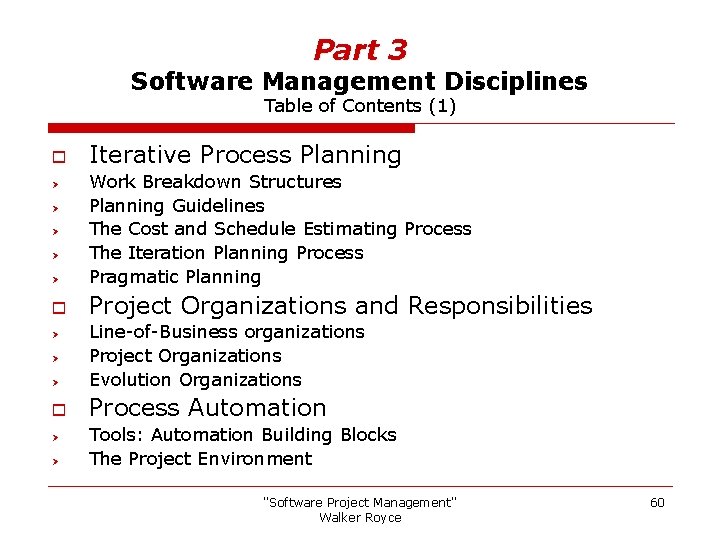
Part 3 Software Management Disciplines Table of Contents (1) o Iterative Process Planning Ø Work Breakdown Structures Planning Guidelines The Cost and Schedule Estimating Process The Iteration Planning Process Pragmatic Planning o Project Organizations and Responsibilities Ø Ø Ø Line-of-Business organizations Project Organizations Evolution Organizations o Process Automation Ø Ø Tools: Automation Building Blocks The Project Environment "Software Project Management" Walker Royce 60
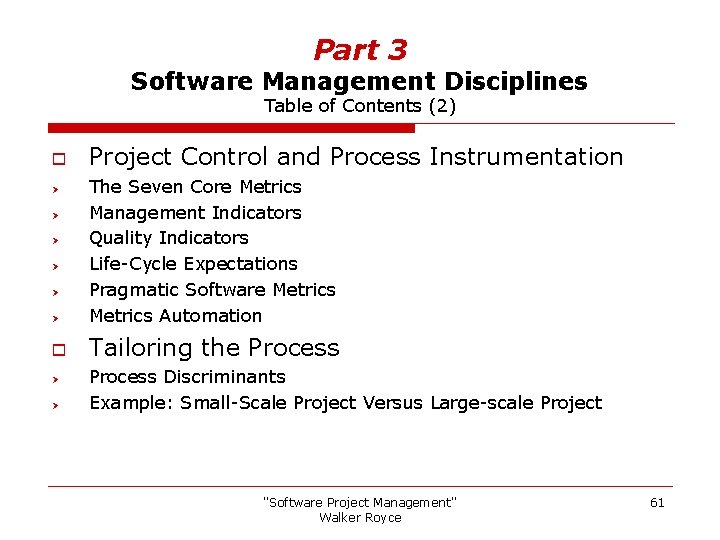
Part 3 Software Management Disciplines Table of Contents (2) o Project Control and Process Instrumentation Ø The Seven Core Metrics Management Indicators Quality Indicators Life-Cycle Expectations Pragmatic Software Metrics Automation o Tailoring the Process Ø Ø Ø Ø Process Discriminants Example: Small-Scale Project Versus Large-scale Project "Software Project Management" Walker Royce 61

Part 3 Iterative Process Planning Work Breakdown Structures q The development of a work breakdown structure is dependent on the project management style, organizational culture, customer preference, financial constraints and several other hard-to-define parameters. q A WBS is simply a hierarchy of elements that decomposes the project plan into the discrete work tasks. q A WBS provides the following information structure: Ø A delineation of all significant work Ø A clear task decomposition for assignment of responsibilities Ø A framework for scheduling, budgeting, and expenditure tracking. "Software Project Management" Walker Royce 62

Part 3 Iterative Process Planning Guidelines q Two simple planning guidelines should be considered when a project plan is being initiated or assessed. FIRST-LEVEL WBS ELEMENT DEFAULT BUDGET Management 10% Environment 10% Requirements 10% Design 15% Implementation 25% Assessment 25% Deployment 5% Total DOMAIN INCEPTION ELABORATION CONSTRUCTION TRANSITION Effort 5% 20% 65% 10% Schedule 10% 30% 50% 10% The second guideline prescribes the allocation of effort and schedule across the life-cycle phases 100% The first guideline prescribes a default allocation of costs among the first-level WBS elements "Software Project Management" Walker Royce 63

Part 3 Iterative Process Planning The Cost and Schedule Estimating Process q Project plans need to be derived from two perspectives. Ø Forward-looking: 1. The software project manager develops a characterization of the overall size, process, environment, people, and quality required for the project 2. A macro-level estimate of the total effort and schedule is developed using a software cost estimation model 3. The software project manager partitions the estimate for the effort into a top-level WBS, also partitions the schedule into major milestone dates and partitions the effort into a staffing profile 4. At this point, subproject managers are given the responsibility for decomposing each of the WBS elements into lower levels using their top-level allocation, staffing profile, and major milestone dates as constraints. "Software Project Management" Walker Royce 64

Part 3 Iterative Process Planning The Cost and Schedule Estimating Process Ø Backward-looking: 1. The lowest level WBS elements are elaborated into detailed tasks, for which budgets and schedules are estimated by the responsible WBS element manager. 2. Estimates are combined and integrated into higher level budgets and milestones. 3. Comparisons are made with the top-down budgets and schedule milestones. Gross differences are assessed and adjustments are made in order to converge on agreement between the top-down and the bottom-up estimates. "Software Project Management" Walker Royce 65

Part 3 Iterative Process Planning The Iteration Planning Process Engineering Stage Inception Feasibility iterations Elaboration Architecture iterations Production Stage Construction Usable iterations Engineering stage planning emphasis: Ø Ø Ø Macro-level task estimation for production-stage artifacts Micro-level task estimation for engineering artifacts Stakeholder concurrence Coarse-grained variance analysis of actual vs. planned expenditures Tuning the top-down projectindependent planning guidelines into project-specific planning guidelines. Transition Product releases Production stage planning emphasis: Ø Ø Micro-level task estimation for production-stage artifacts Macro-level task estimation for engineering artifacts Stakeholder concurrence Fine-grained variance analysis of actual vs. planned expenditures "Software Project Management" Walker Royce 66

Part 3 Project Organizations and Responsibilities Line-of-Business Organizations Default roles in a software line-of-business organizations Organization Manager Software Engineering Process Authority Project Review Authority Process definition Process improvement • • Project compliance Periodic risk assessment • • Software Engineering Environment Authority • Infrastructure Process automation • • • Project A Manager Project B Manager Project administration Engineering skill centers Professional development Project N Manager "Software Project Management" Walker Royce 67

Part 3 Project Organizations and Responsibilities Project Organizations Software Management Team Artifacts Ø Ø Ø v Systems Engineering v Financial Administration v Quality Assurance Business case Vision Software development plan Work breakdown structure Status assessments Requirements set Life-Cycle Focus Responsibilities Ø Ø Ø Ø Resource commitments Personnel assignments Plans, priorities, Stakeholder satisfaction Scope definition Risk management Project control Inception Elaboration Construction Transition Elaboration phase planning Team formulating Contract base lining Architecture costs Construction phase planning Full staff recruitment Risk resolution Product acceptance criteria Construction costs Transition phase planning Construction plan optimization Risk management Customer satisfaction Contract closure Sales support Next-generation planning "Software Project Management" Walker Royce 68

Part 3 Project Organizations and Responsibilities Project Organizations Software Architecture Team Artifacts Ø Ø v v Architecture description Requirements set Design set Release specifications Demonstrations Use-case modelers Design modelers Performance analysts Responsibilities Ø Ø Ø Requirements trade-offs Design trade-offs Component selection Initial integration Technical risk solution Life-Cycle Focus Inception Elaboration Construction Transition Architecture prototyping Make/buy trade-offs Primary scenario definition Architecture evaluation criteria definition Architecture base lining Primary scenario demonstration Make/buy trade-offs base lining Architecture maintenance Multiple-component issue resolution Performance tuning Quality improvements "Software Project Management" Walker Royce 69
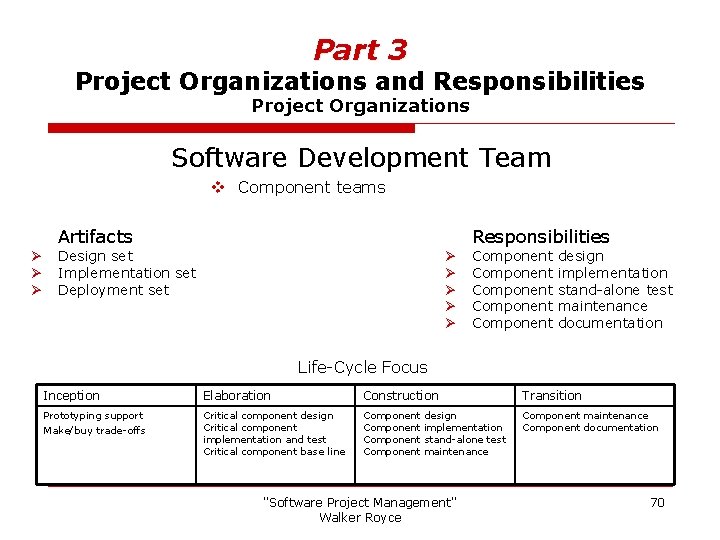
Part 3 Project Organizations and Responsibilities Project Organizations Software Development Team v Component teams Artifacts Ø Ø Ø Responsibilities Design set Implementation set Deployment set Ø Ø Ø Component Component design implementation stand-alone test maintenance documentation Life-Cycle Focus Inception Elaboration Construction Transition Prototyping support Make/buy trade-offs Critical component design Critical component implementation and test Critical component base line Component Component maintenance Component documentation design implementation stand-alone test maintenance "Software Project Management" Walker Royce 70

Part 3 Project Organizations and Responsibilities Project Organizations Software Assessment Team Artifacts Ø Ø Ø Ø v v Deployment set SCO database User manual Environment Release specifications Release descriptions Deployment documents Release testing Change management Deployment Environment support Life-Cycle Focus Responsibilities Ø Ø Ø Ø Project infrastructure Independent testing Requirements verification Metrics analysis Configuration control Change management User deployment Inception Elaboration Construction Transition Infrastructure planning Primary scenario prototyping Infrastructure base lining Architecture release testing Change management Initial user manual Infrastructure upgrades Release testing Change management User manual base line Requirements verification Infrastructure maintenance Release base lining Change management Deployment to users Requirements verification "Software Project Management" Walker Royce 71

Part 3 Project Organizations and Responsibilities Evolution of Organizations Software management 50% Software architecture 20% Software development 20% Software management 10% Software assessment 10% Inception Transition Software architecture 50% Software development 35% Software assessment 20% Elaboration Construction Software management 10% Software architecture 5% Software development 20% Software management 10% Software assessment 50% Software architecture 10% "Software Project Management" Walker Royce Software development 50% Software assessment 30% 72
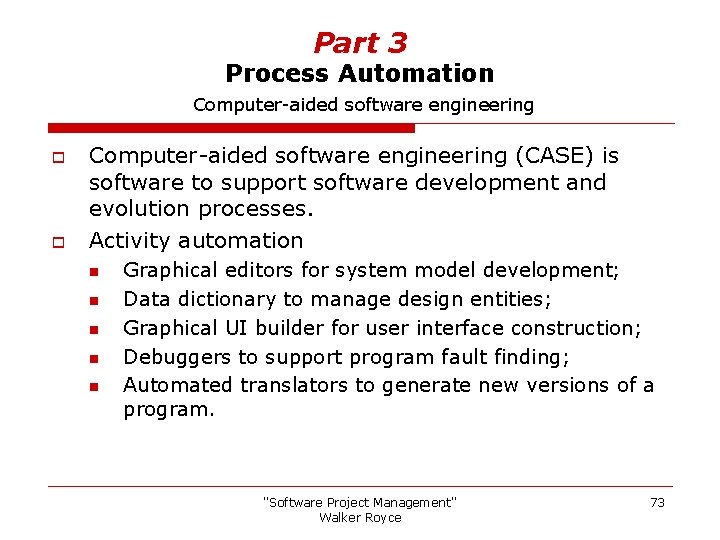
Part 3 Process Automation Computer-aided software engineering o o Computer-aided software engineering (CASE) is software to support software development and evolution processes. Activity automation n n Graphical editors for system model development; Data dictionary to manage design entities; Graphical UI builder for user interface construction; Debuggers to support program fault finding; Automated translators to generate new versions of a program. "Software Project Management" Walker Royce 73
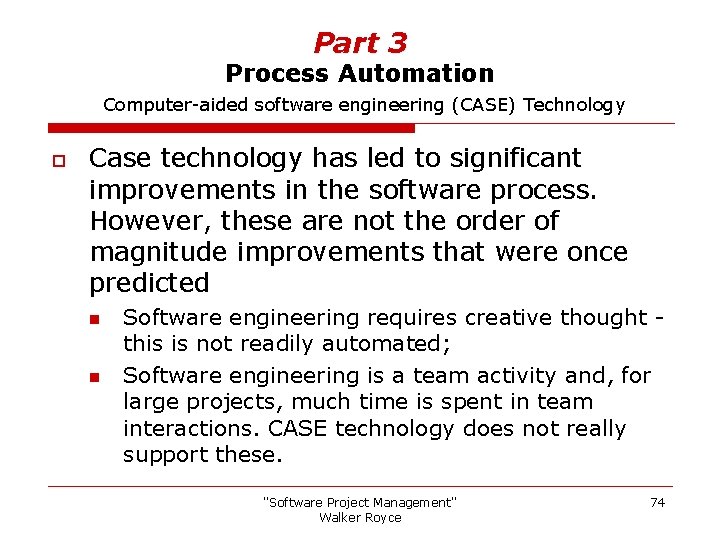
Part 3 Process Automation Computer-aided software engineering (CASE) Technology o Case technology has led to significant improvements in the software process. However, these are not the order of magnitude improvements that were once predicted n n Software engineering requires creative thought this is not readily automated; Software engineering is a team activity and, for large projects, much time is spent in team interactions. CASE technology does not really support these. "Software Project Management" Walker Royce 74

Part 3 Process Automation CASE Classification o o Classification helps us understand the different types of CASE tools and their support for process activities. Functional perspective n o Process perspective n o Tools are classified according to their specific function. Tools are classified according to process activities that are supported. Integration perspective n Tools are classified according to their organisation into integrated units. "Software Project Management" Walker Royce 75
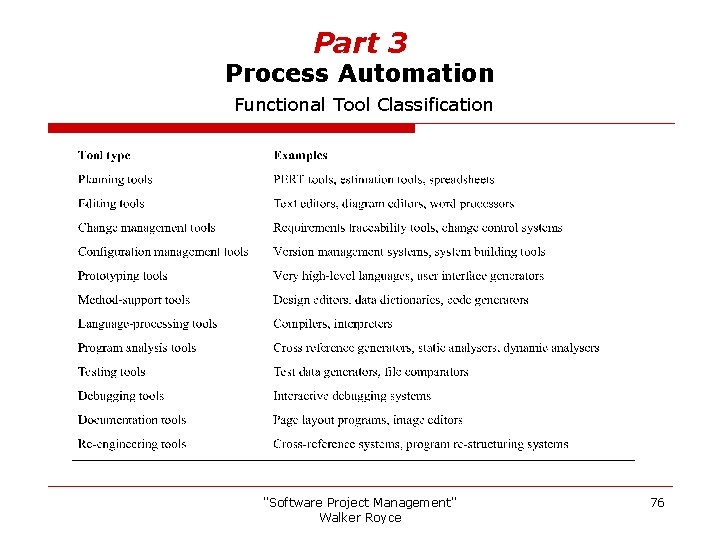
Part 3 Process Automation Functional Tool Classification "Software Project Management" Walker Royce 76
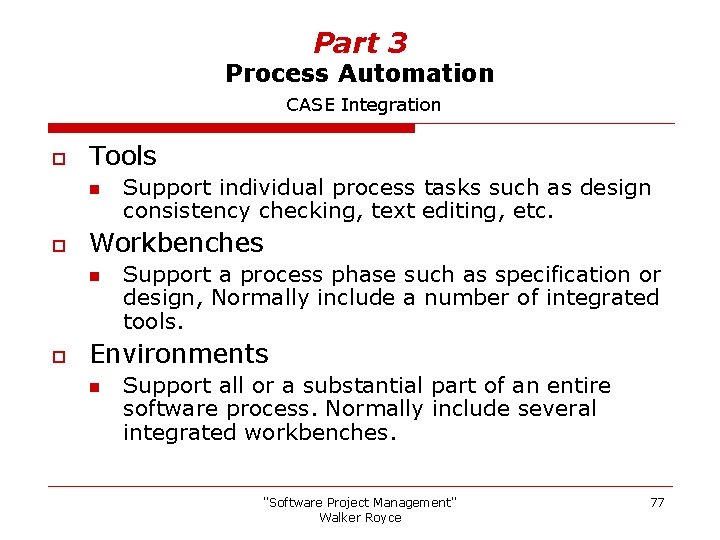
Part 3 Process Automation CASE Integration o Tools n o Workbenches n o Support individual process tasks such as design consistency checking, text editing, etc. Support a process phase such as specification or design, Normally include a number of integrated tools. Environments n Support all or a substantial part of an entire software process. Normally include several integrated workbenches. "Software Project Management" Walker Royce 77
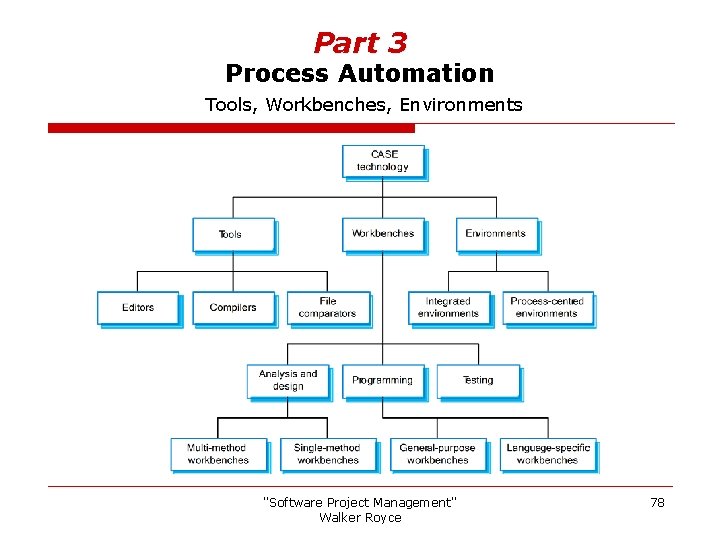
Part 3 Process Automation Tools, Workbenches, Environments "Software Project Management" Walker Royce 78
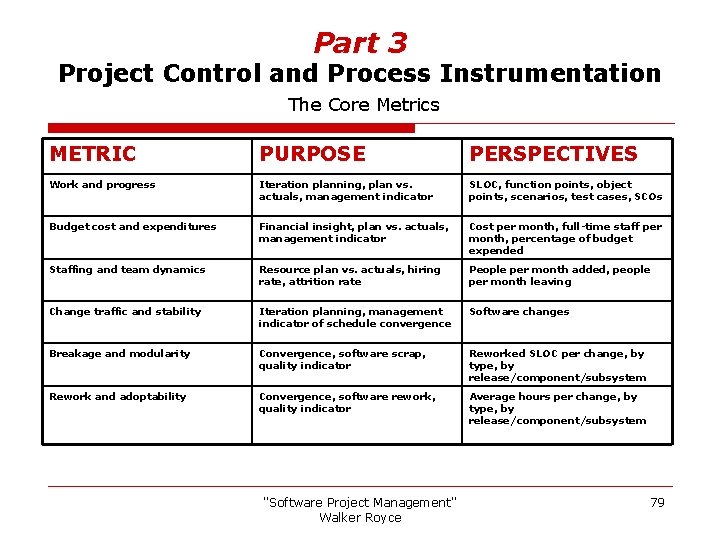
Part 3 Project Control and Process Instrumentation The Core Metrics METRIC PURPOSE PERSPECTIVES Work and progress Iteration planning, plan vs. actuals, management indicator SLOC, function points, object points, scenarios, test cases, SCOs Budget cost and expenditures Financial insight, plan vs. actuals, management indicator Cost per month, full-time staff per month, percentage of budget expended Staffing and team dynamics Resource plan vs. actuals, hiring rate, attrition rate People per month added, people per month leaving Change traffic and stability Iteration planning, management indicator of schedule convergence Software changes Breakage and modularity Convergence, software scrap, quality indicator Reworked SLOC per change, by type, by release/component/subsystem Rework and adoptability Convergence, software rework, quality indicator Average hours per change, by type, by release/component/subsystem "Software Project Management" Walker Royce 79
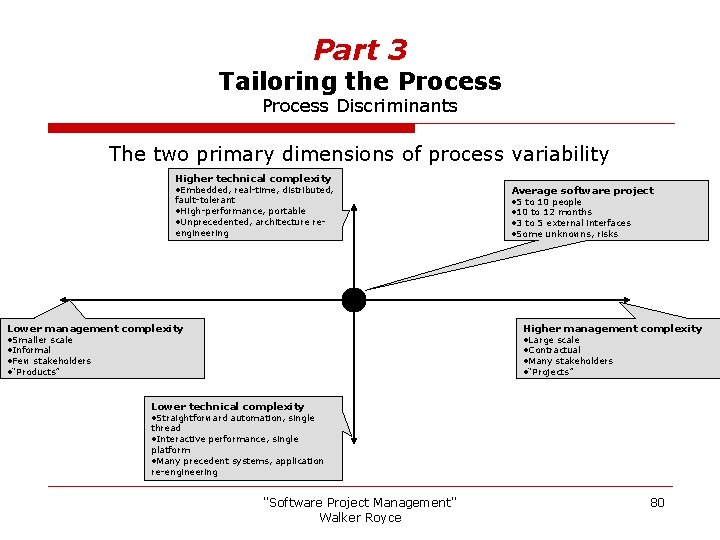
Part 3 Tailoring the Process Discriminants The two primary dimensions of process variability Higher technical complexity • Embedded, real-time, distributed, fault-tolerant • High-performance, portable • Unprecedented, architecture reengineering Lower management complexity Average software project • 5 to 10 people • 10 to 12 months • 3 to 5 external interfaces • Some unknowns, risks Higher management complexity • Smaller scale • Informal • Few stakeholders • “Products” • Large scale • Contractual • Many stakeholders • “Projects” Lower technical complexity • Straightforward automation, single thread • Interactive performance, single platform • Many precedent systems, application re-engineering "Software Project Management" Walker Royce 80

Part 3 Tailoring the Process Example: Small-Scale Project vs. Large-Scale Project Differences in workflow priorities between small and large projects Rank Small Commercial Project Large Complex Project 1 2 3 4 5 6 7 Design Management Implementation Design Deployment Requirements Assessments Environment Management Implementation Environment Deployment "Software Project Management" Walker Royce 81

Part 4 Looking Forward "Software Project Management" Walker Royce 82

Part 4 Looking Forward Table of Contents o Modern Project Profiles Ø Continuous Integration Early Risk Resolution Evolutionary Requirements Teamwork Among Stakeholders Top 10 Software Management Principles Software Management Best Practices o Next-Generation Software Economics Ø Ø Ø Next-Generation Cost Models Modern Software Economics o Modern Process Transitions Ø Ø Ø Culture Shifts Denouement "Software Project Management" Walker Royce 83
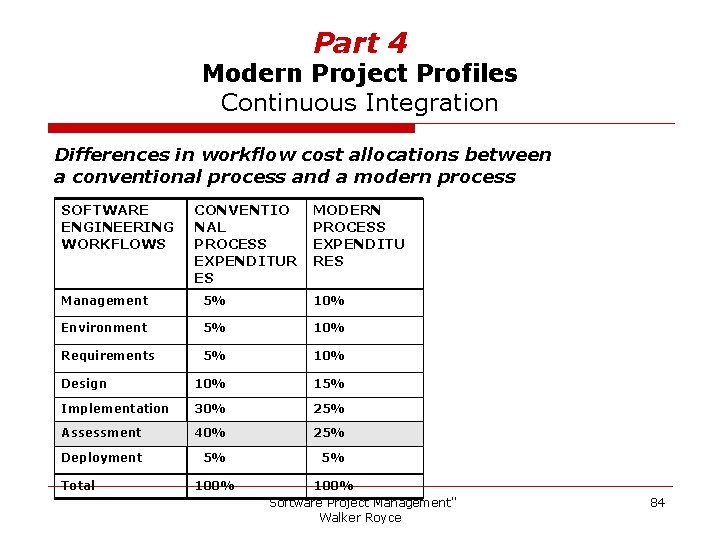
Part 4 Modern Project Profiles Continuous Integration Differences in workflow cost allocations between a conventional process and a modern process SOFTWARE ENGINEERING WORKFLOWS CONVENTIO NAL PROCESS EXPENDITUR ES MODERN PROCESS EXPENDITU RES Management 5% 10% Environment 5% 10% Requirements 5% 10% Design 10% 15% Implementation 30% 25% Assessment 40% 25% Deployment 5% 5% Total 100% "Software Project Management" Walker Royce 84
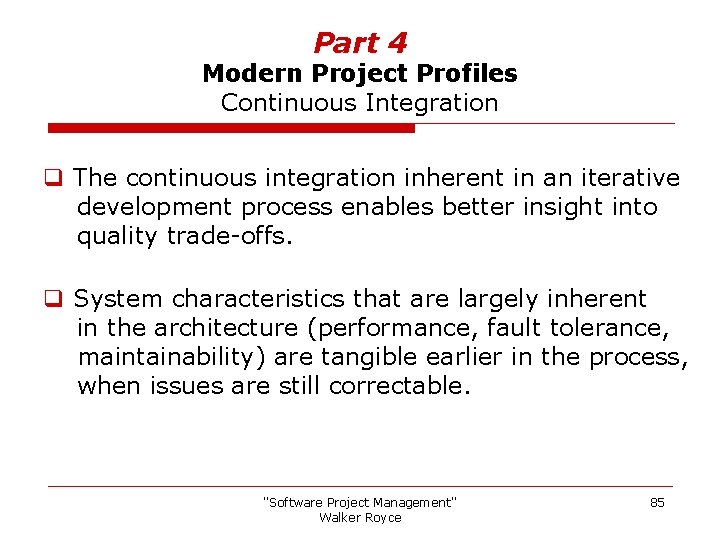
Part 4 Modern Project Profiles Continuous Integration q The continuous integration inherent in an iterative development process enables better insight into quality trade-offs. q System characteristics that are largely inherent in the architecture (performance, fault tolerance, maintainability) are tangible earlier in the process, when issues are still correctable. "Software Project Management" Walker Royce 85
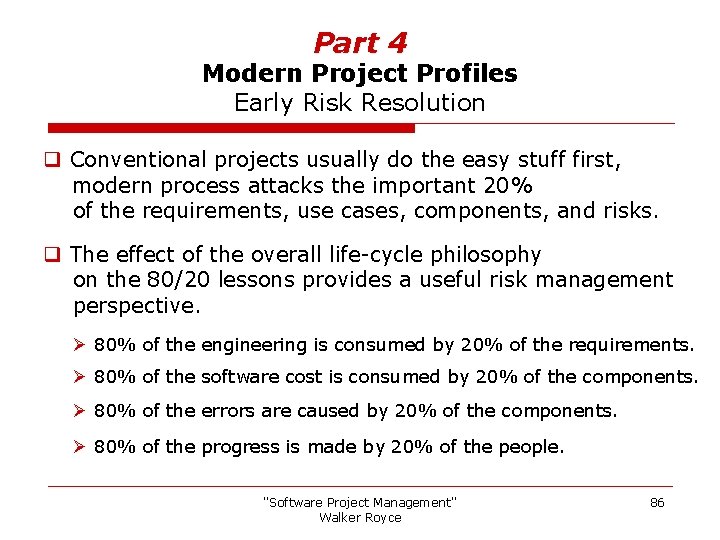
Part 4 Modern Project Profiles Early Risk Resolution q Conventional projects usually do the easy stuff first, modern process attacks the important 20% of the requirements, use cases, components, and risks. q The effect of the overall life-cycle philosophy on the 80/20 lessons provides a useful risk management perspective. Ø 80% of the engineering is consumed by 20% of the requirements. Ø 80% of the software cost is consumed by 20% of the components. Ø 80% of the errors are caused by 20% of the components. Ø 80% of the progress is made by 20% of the people. "Software Project Management" Walker Royce 86

Part 4 Modern Project Profiles Evolutionary Requirements q Conventional approaches decomposed system requirements into subsystem requirements, subsystem requirements into component requirements, and component requirements into unit requirements. q The organization of requirements was structured so traceability was simple. q Most modern architectures that use commercial components, legacy components, distributed resources and object-oriented methods are not trivially traced to the requirements they satisfy. q The artifacts are now intended to evolve along with the process, with more and more fidelity as the life-cycle progresses and the requirements understanding matures. "Software Project Management" Walker Royce 87

Part 4 Modern Project Profiles Teamwork among stakeholders q Many aspects of the classic development process cause stakeholder relationships to degenerate into mutual distrust, making it difficult to balance requirements, product features, and plans. q The process with more-effective working relationships between stakeholders requires that customers, users and monitors have both applications and software expertise, remain focused on the delivery of a usable system q It also requires a development organization that is focused on achieving customer satisfaction and high product quality in a profitable manner. The transition from the exchange of mostly paper artifacts to demonstration of intermediate results is one of the crucial mechanisms for promoting teamwork among stakeholders. "Software Project Management" Walker Royce 88

Part 4 Modern Project Profiles Top 10 Software Management Principles 1. Base the process on an architecture-first approach – rework rates remain stable over the project life cycle. 2. Establish an iterative life-cycle process that confronts risk early 3. Transition design methods to emphasize component-based development 4. Establish a change management environment – the dynamics of iterative development, including concurrent workflows by different teams working on shared artifacts, necessitate highly controlled baselines 5. Enhance change freedom through tools that support round-trip engineering "Software Project Management" Walker Royce 89
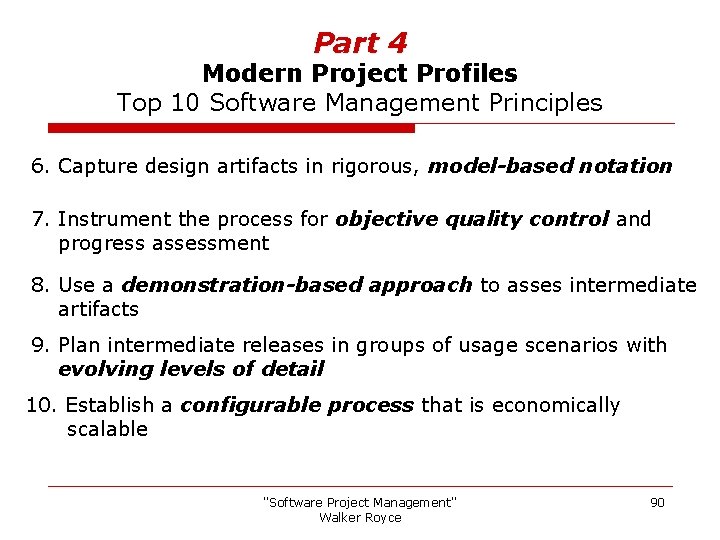
Part 4 Modern Project Profiles Top 10 Software Management Principles 6. Capture design artifacts in rigorous, model-based notation 7. Instrument the process for objective quality control and progress assessment 8. Use a demonstration-based approach to asses intermediate artifacts 9. Plan intermediate releases in groups of usage scenarios with evolving levels of detail 10. Establish a configurable process that is economically scalable "Software Project Management" Walker Royce 90
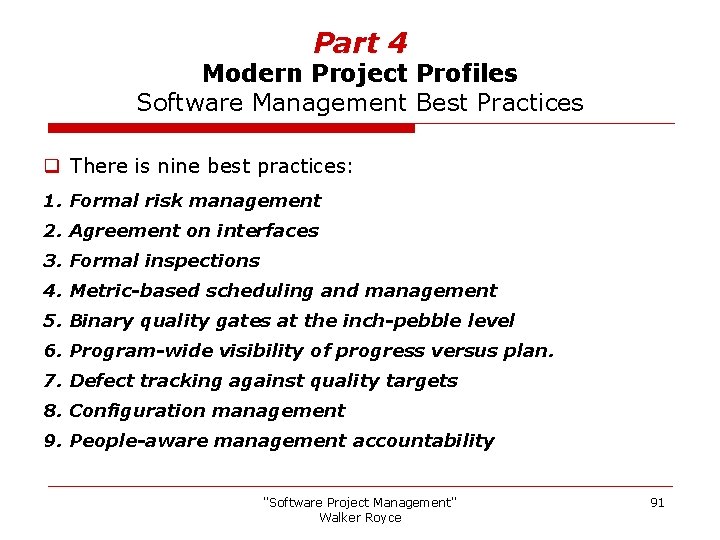
Part 4 Modern Project Profiles Software Management Best Practices q There is nine best practices: 1. Formal risk management 2. Agreement on interfaces 3. Formal inspections 4. Metric-based scheduling and management 5. Binary quality gates at the inch-pebble level 6. Program-wide visibility of progress versus plan. 7. Defect tracking against quality targets 8. Configuration management 9. People-aware management accountability "Software Project Management" Walker Royce 91
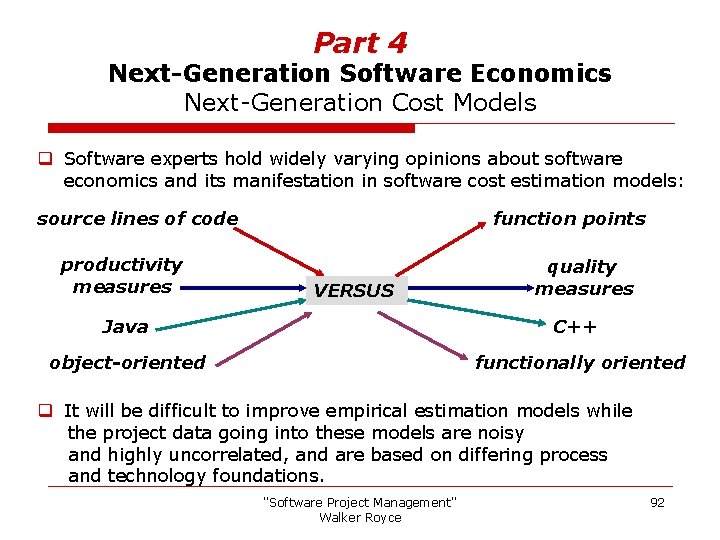
Part 4 Next-Generation Software Economics Next-Generation Cost Models q Software experts hold widely varying opinions about software economics and its manifestation in software cost estimation models: source lines of code productivity measures function points VERSUS quality measures Java C++ object-oriented functionally oriented q It will be difficult to improve empirical estimation models while the project data going into these models are noisy and highly uncorrelated, and are based on differing process and technology foundations. "Software Project Management" Walker Royce 92
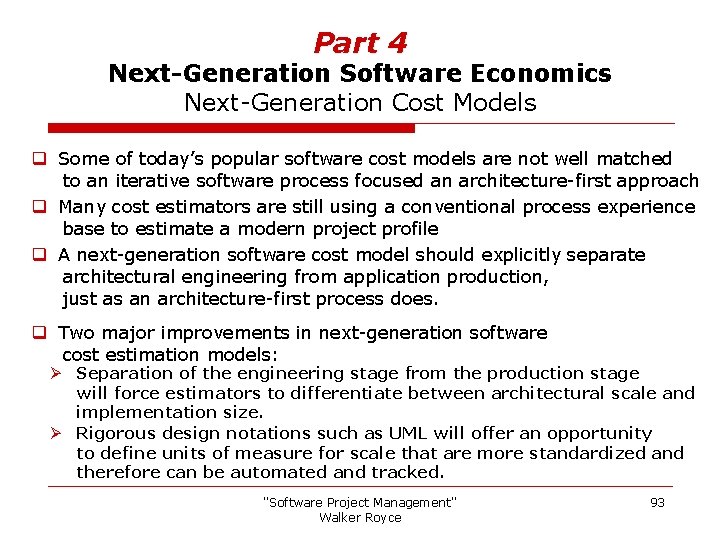
Part 4 Next-Generation Software Economics Next-Generation Cost Models q Some of today’s popular software cost models are not well matched to an iterative software process focused an architecture-first approach q Many cost estimators are still using a conventional process experience base to estimate a modern project profile q A next-generation software cost model should explicitly separate architectural engineering from application production, just as an architecture-first process does. q Two major improvements in next-generation software cost estimation models: Ø Separation of the engineering stage from the production stage will force estimators to differentiate between architectural scale and implementation size. Ø Rigorous design notations such as UML will offer an opportunity to define units of measure for scale that are more standardized and therefore can be automated and tracked. "Software Project Management" Walker Royce 93
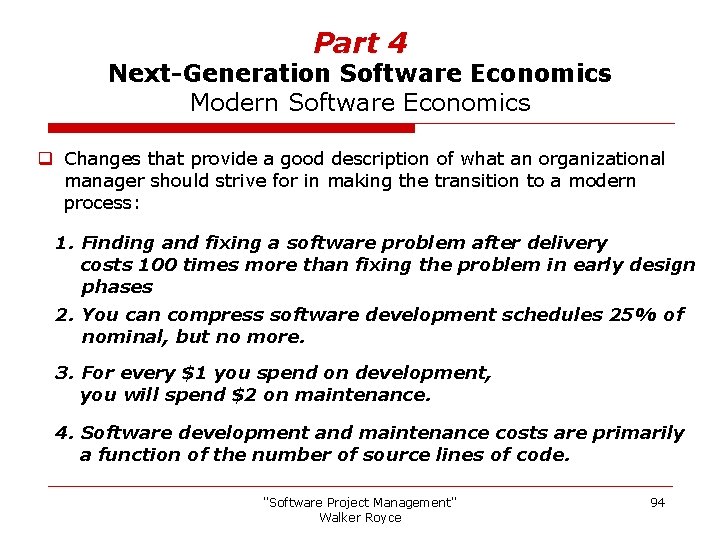
Part 4 Next-Generation Software Economics Modern Software Economics q Changes that provide a good description of what an organizational manager should strive for in making the transition to a modern process: 1. Finding and fixing a software problem after delivery costs 100 times more than fixing the problem in early design phases 2. You can compress software development schedules 25% of nominal, but no more. 3. For every $1 you spend on development, you will spend $2 on maintenance. 4. Software development and maintenance costs are primarily a function of the number of source lines of code. "Software Project Management" Walker Royce 94
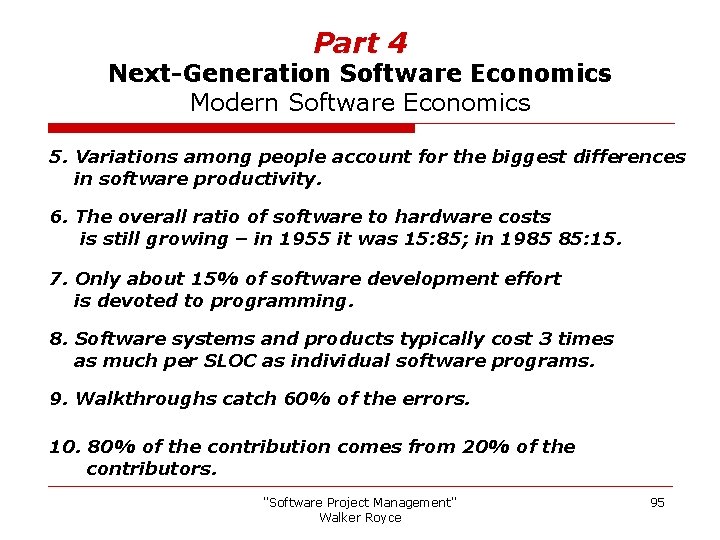
Part 4 Next-Generation Software Economics Modern Software Economics 5. Variations among people account for the biggest differences in software productivity. 6. The overall ratio of software to hardware costs is still growing – in 1955 it was 15: 85; in 1985 85: 15. 7. Only about 15% of software development effort is devoted to programming. 8. Software systems and products typically cost 3 times as much per SLOC as individual software programs. 9. Walkthroughs catch 60% of the errors. 10. 80% of the contribution comes from 20% of the contributors. "Software Project Management" Walker Royce 95
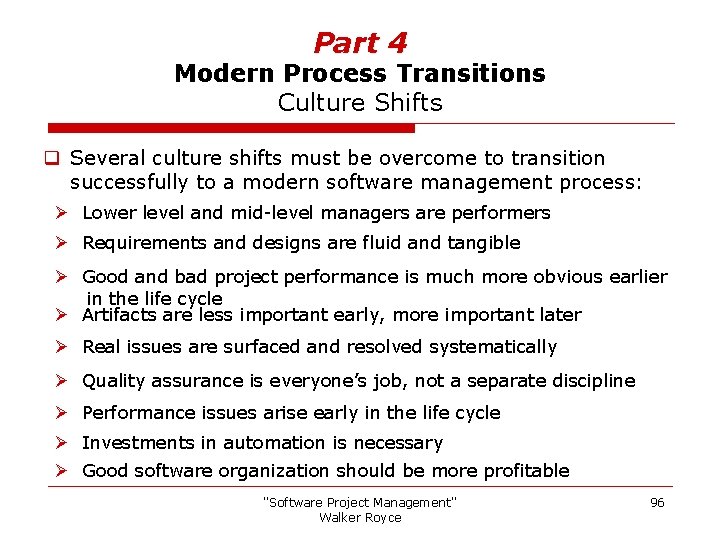
Part 4 Modern Process Transitions Culture Shifts q Several culture shifts must be overcome to transition successfully to a modern software management process: Ø Lower level and mid-level managers are performers Ø Requirements and designs are fluid and tangible Ø Good and bad project performance is much more obvious earlier in the life cycle Ø Artifacts are less important early, more important later Ø Real issues are surfaced and resolved systematically Ø Quality assurance is everyone’s job, not a separate discipline Ø Performance issues arise early in the life cycle Ø Investments in automation is necessary Ø Good software organization should be more profitable "Software Project Management" Walker Royce 96
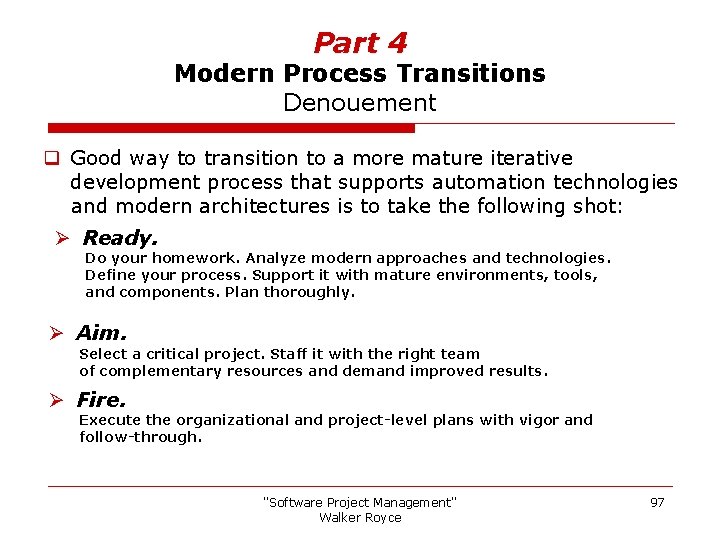
Part 4 Modern Process Transitions Denouement q Good way to transition to a more mature iterative development process that supports automation technologies and modern architectures is to take the following shot: Ø Ready. Do your homework. Analyze modern approaches and technologies. Define your process. Support it with mature environments, tools, and components. Plan thoroughly. Ø Aim. Select a critical project. Staff it with the right team of complementary resources and demand improved results. Ø Fire. Execute the organizational and project-level plans with vigor and follow-through. "Software Project Management" Walker Royce 97
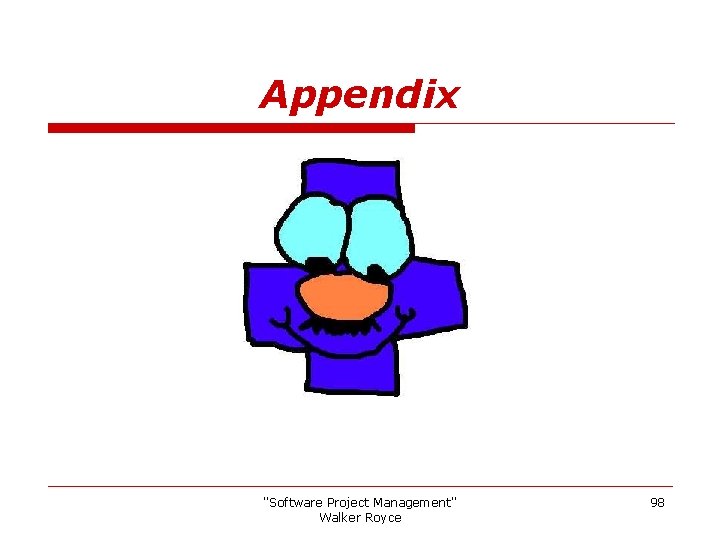
Appendix "Software Project Management" Walker Royce 98
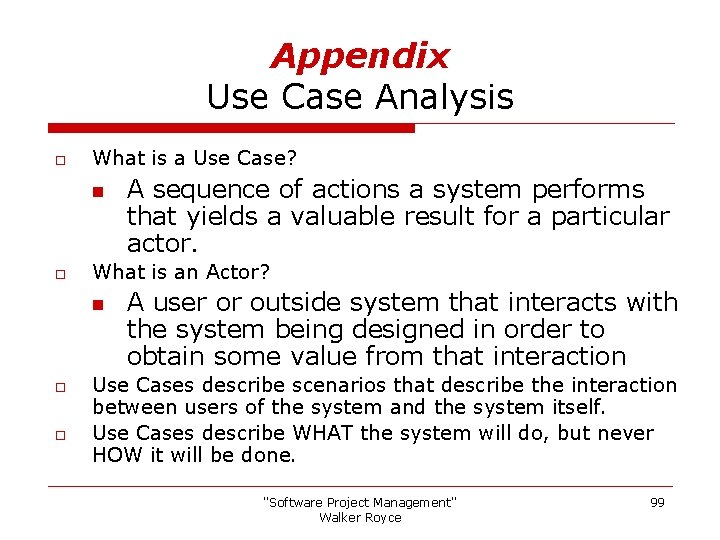
Appendix Use Case Analysis o What is a Use Case? n o What is an Actor? n o o A sequence of actions a system performs that yields a valuable result for a particular actor. A user or outside system that interacts with the system being designed in order to obtain some value from that interaction Use Cases describe scenarios that describe the interaction between users of the system and the system itself. Use Cases describe WHAT the system will do, but never HOW it will be done. "Software Project Management" Walker Royce 99
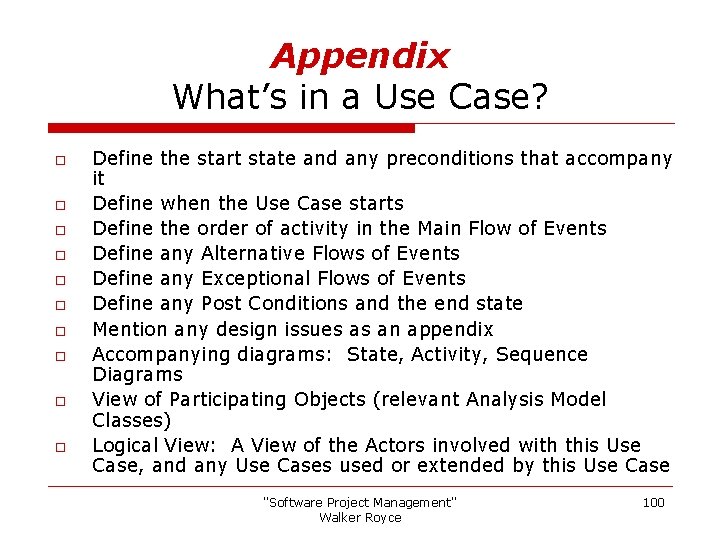
Appendix What’s in a Use Case? o o o o o Define the start state and any preconditions that accompany it Define when the Use Case starts Define the order of activity in the Main Flow of Events Define any Alternative Flows of Events Define any Exceptional Flows of Events Define any Post Conditions and the end state Mention any design issues as an appendix Accompanying diagrams: State, Activity, Sequence Diagrams View of Participating Objects (relevant Analysis Model Classes) Logical View: A View of the Actors involved with this Use Case, and any Use Cases used or extended by this Use Case "Software Project Management" Walker Royce 100
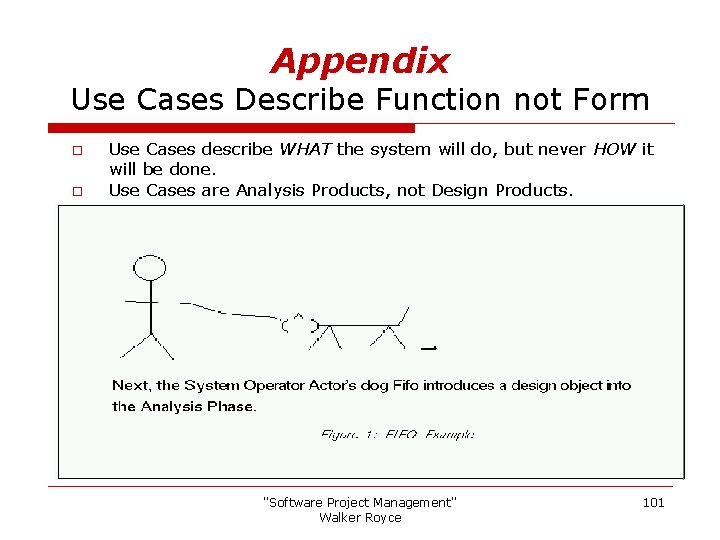
Appendix Use Cases Describe Function not Form o o Use Cases describe WHAT the system will do, but never HOW it will be done. Use Cases are Analysis Products, not Design Products. "Software Project Management" Walker Royce 101
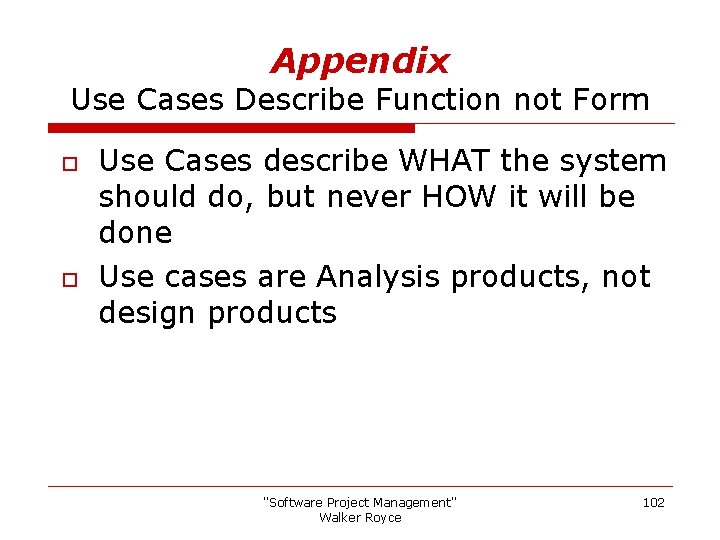
Appendix Use Cases Describe Function not Form o o Use Cases describe WHAT the system should do, but never HOW it will be done Use cases are Analysis products, not design products "Software Project Management" Walker Royce 102

Appendix Benefits of Use Cases o o o Use cases are the primary vehicle for requirements capture in RUP Use cases are described using the language of the customer (language of the domain which is defined in the glossary) Use cases provide a contractual delivery process (RUP is Use Case Driven) Use cases provide an easily-understood communication mechanism When requirements are traced, they make it difficult for requirements to fall through the cracks Use cases provide a concise summary of what the system should do at an abstract (low modification cost) level. "Software Project Management" Walker Royce 103

Appendix Difficulties with Use Cases o o As functional decompositions, it is often difficult to make the transition from functional description to object description to class design Reuse at the class level can be hindered by each developer “taking a Use Case and running with it”. Since UCs do not talk about classes, developers often wind up in a vacuum during object analysis, and can often wind up doing things their own way, making reuse difficult Use Cases make stating non-functional requirements difficult (where do you say that X must execute at Y/sec? ) Testing functionality is straightforward, but unit testing the particular implementations and non-functional requirements is not obvious "Software Project Management" Walker Royce 104
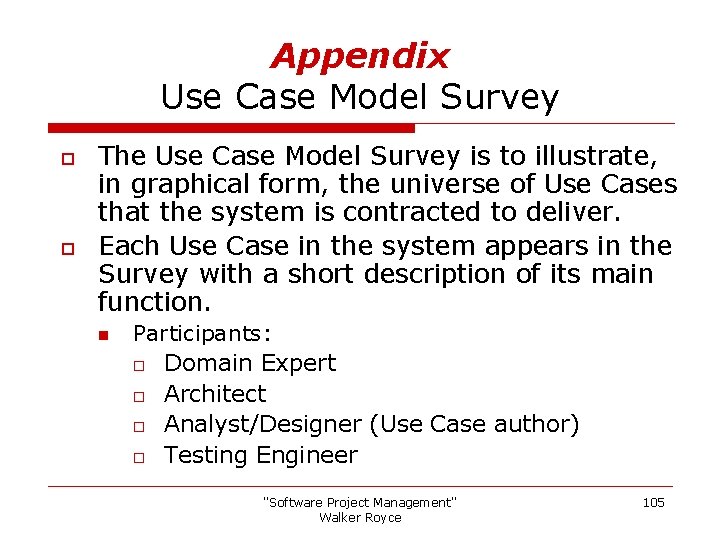
Appendix Use Case Model Survey o o The Use Case Model Survey is to illustrate, in graphical form, the universe of Use Cases that the system is contracted to deliver. Each Use Case in the system appears in the Survey with a short description of its main function. n Participants: o Domain Expert o Architect o Analyst/Designer (Use Case author) o Testing Engineer "Software Project Management" Walker Royce 105
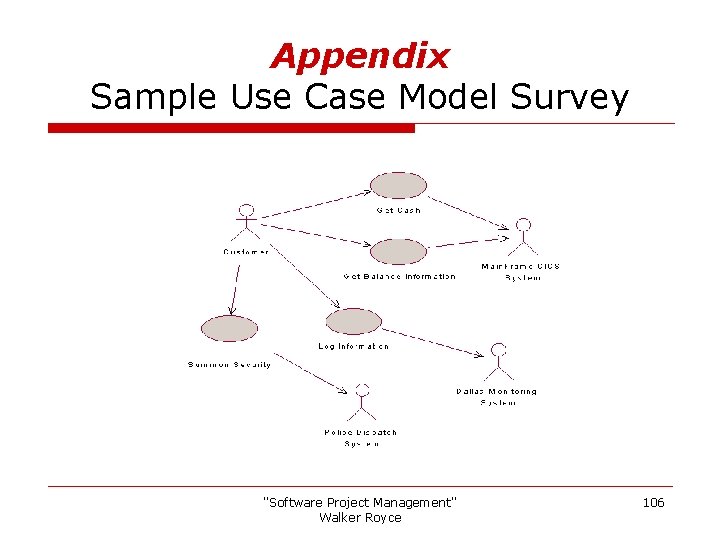
Appendix Sample Use Case Model Survey "Software Project Management" Walker Royce 106
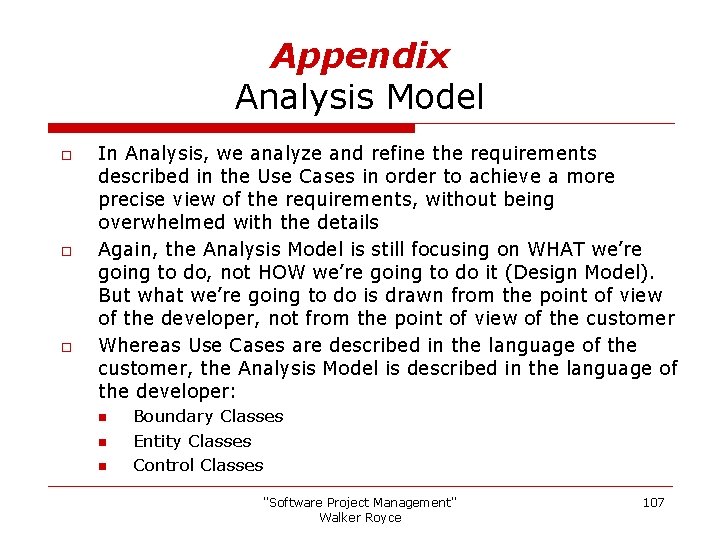
Appendix Analysis Model o o o In Analysis, we analyze and refine the requirements described in the Use Cases in order to achieve a more precise view of the requirements, without being overwhelmed with the details Again, the Analysis Model is still focusing on WHAT we’re going to do, not HOW we’re going to do it (Design Model). But what we’re going to do is drawn from the point of view of the developer, not from the point of view of the customer Whereas Use Cases are described in the language of the customer, the Analysis Model is described in the language of the developer: n n n Boundary Classes Entity Classes Control Classes "Software Project Management" Walker Royce 107
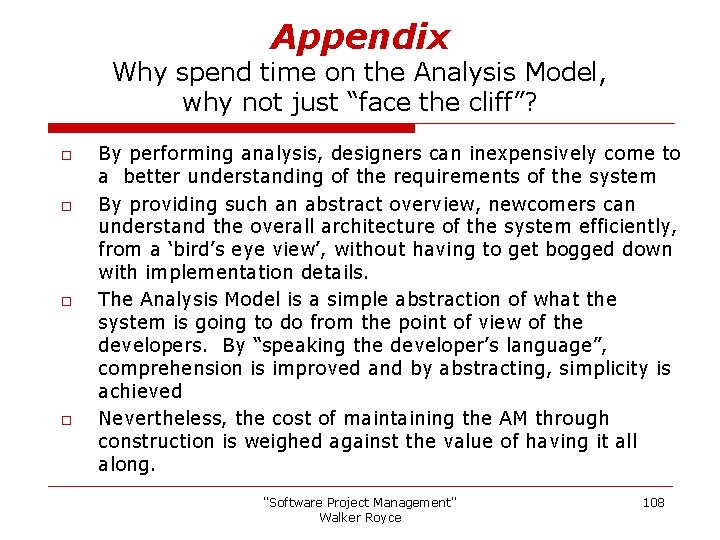
Appendix Why spend time on the Analysis Model, why not just “face the cliff”? o o By performing analysis, designers can inexpensively come to a better understanding of the requirements of the system By providing such an abstract overview, newcomers can understand the overall architecture of the system efficiently, from a ‘bird’s eye view’, without having to get bogged down with implementation details. The Analysis Model is a simple abstraction of what the system is going to do from the point of view of the developers. By “speaking the developer’s language”, comprehension is improved and by abstracting, simplicity is achieved Nevertheless, the cost of maintaining the AM through construction is weighed against the value of having it all along. "Software Project Management" Walker Royce 108
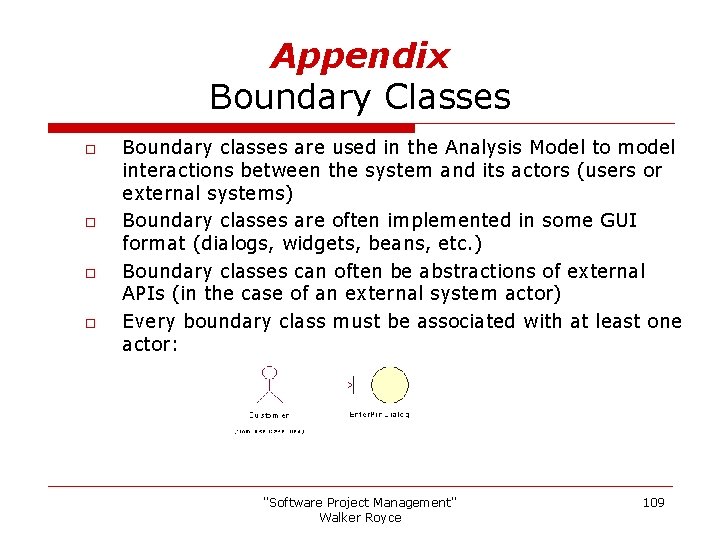
Appendix Boundary Classes o o Boundary classes are used in the Analysis Model to model interactions between the system and its actors (users or external systems) Boundary classes are often implemented in some GUI format (dialogs, widgets, beans, etc. ) Boundary classes can often be abstractions of external APIs (in the case of an external system actor) Every boundary class must be associated with at least one actor: "Software Project Management" Walker Royce 109
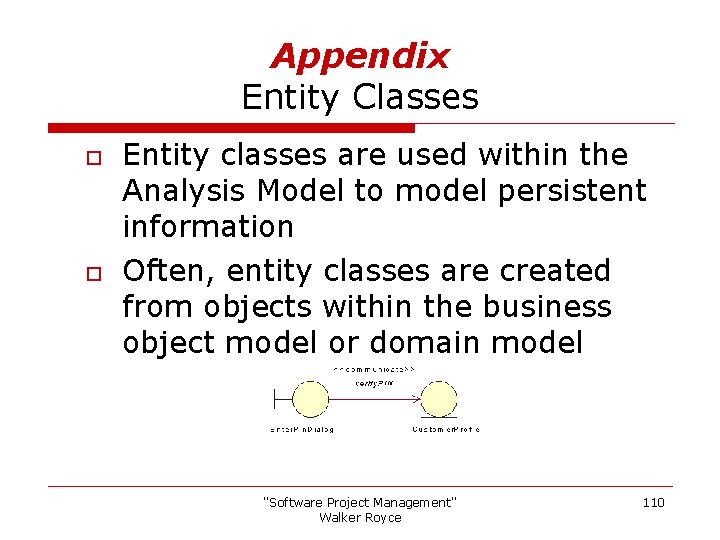
Appendix Entity Classes o o Entity classes are used within the Analysis Model to model persistent information Often, entity classes are created from objects within the business object model or domain model "Software Project Management" Walker Royce 110
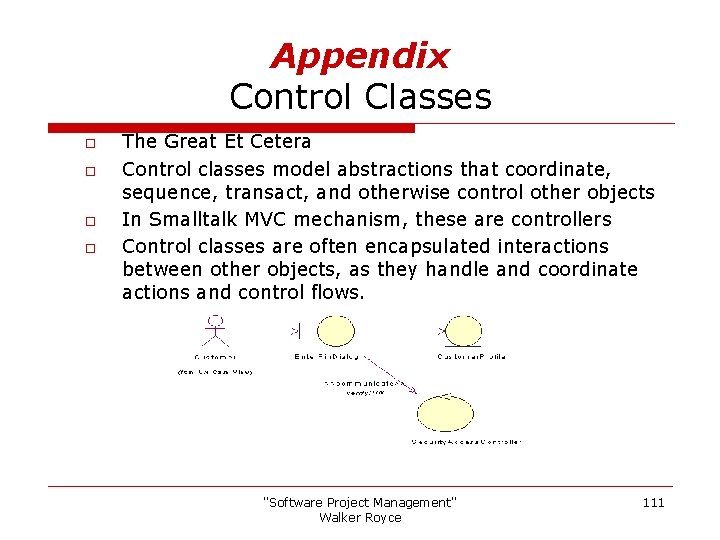
Appendix Control Classes o o The Great Et Cetera Control classes model abstractions that coordinate, sequence, transact, and otherwise control other objects In Smalltalk MVC mechanism, these are controllers Control classes are often encapsulated interactions between other objects, as they handle and coordinate actions and control flows. "Software Project Management" Walker Royce 111
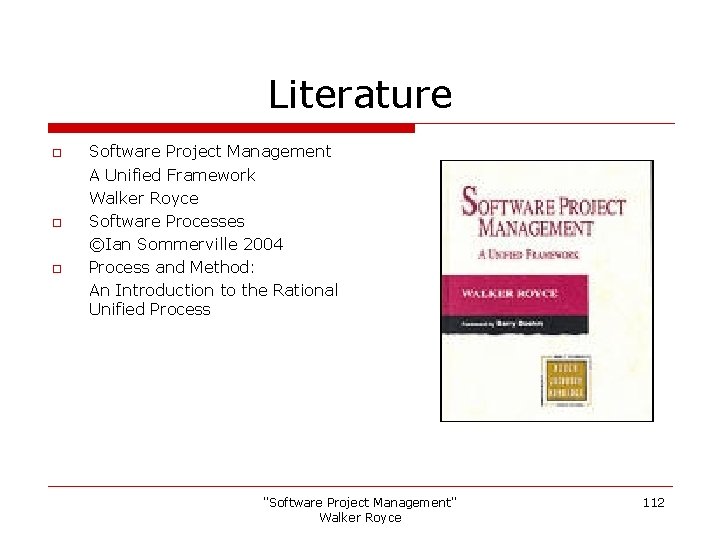
Literature o o o Software Project Management A Unified Framework Walker Royce Software Processes ©Ian Sommerville 2004 Process and Method: An Introduction to the Rational Unified Process "Software Project Management" Walker Royce 112
- Slides: 112